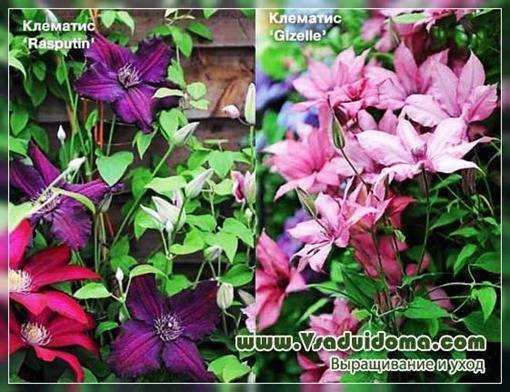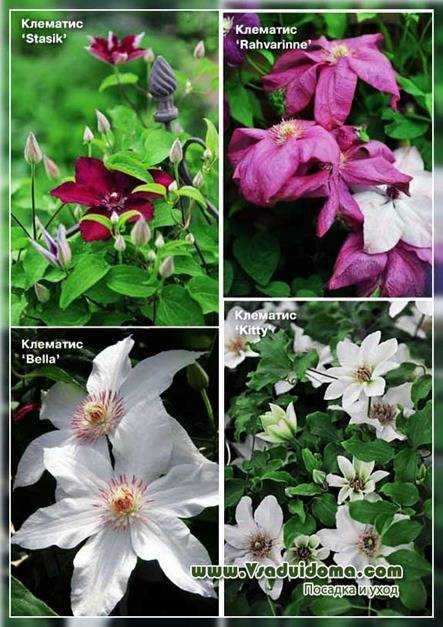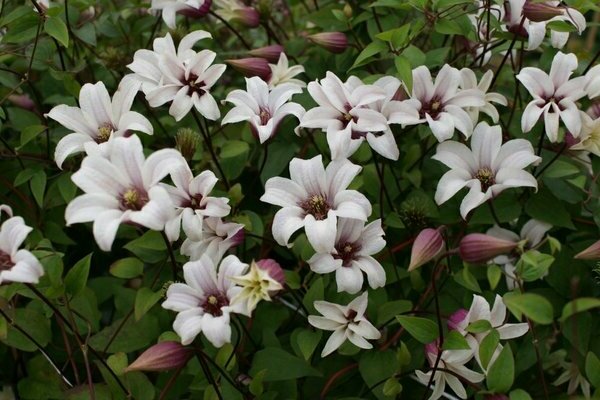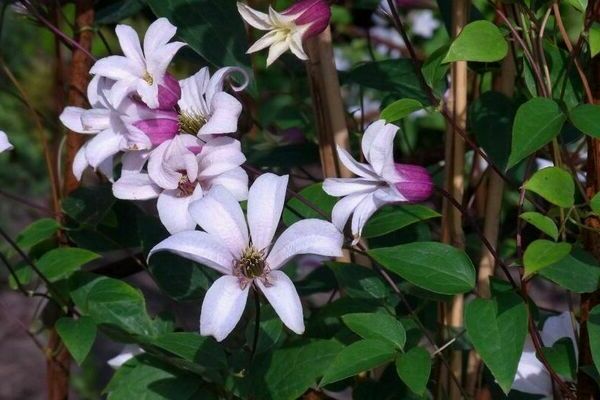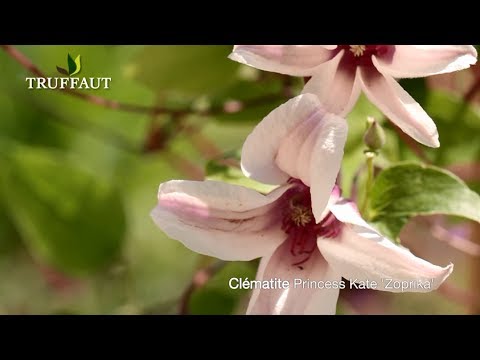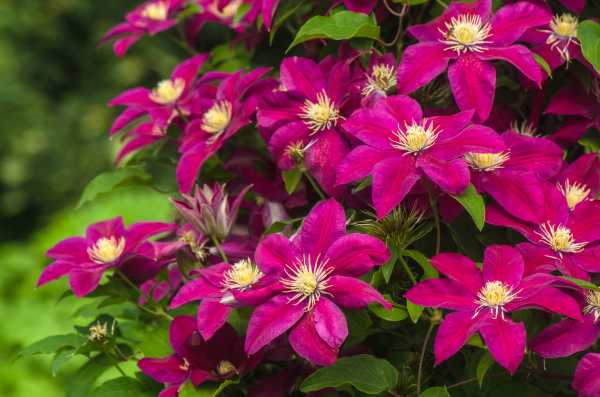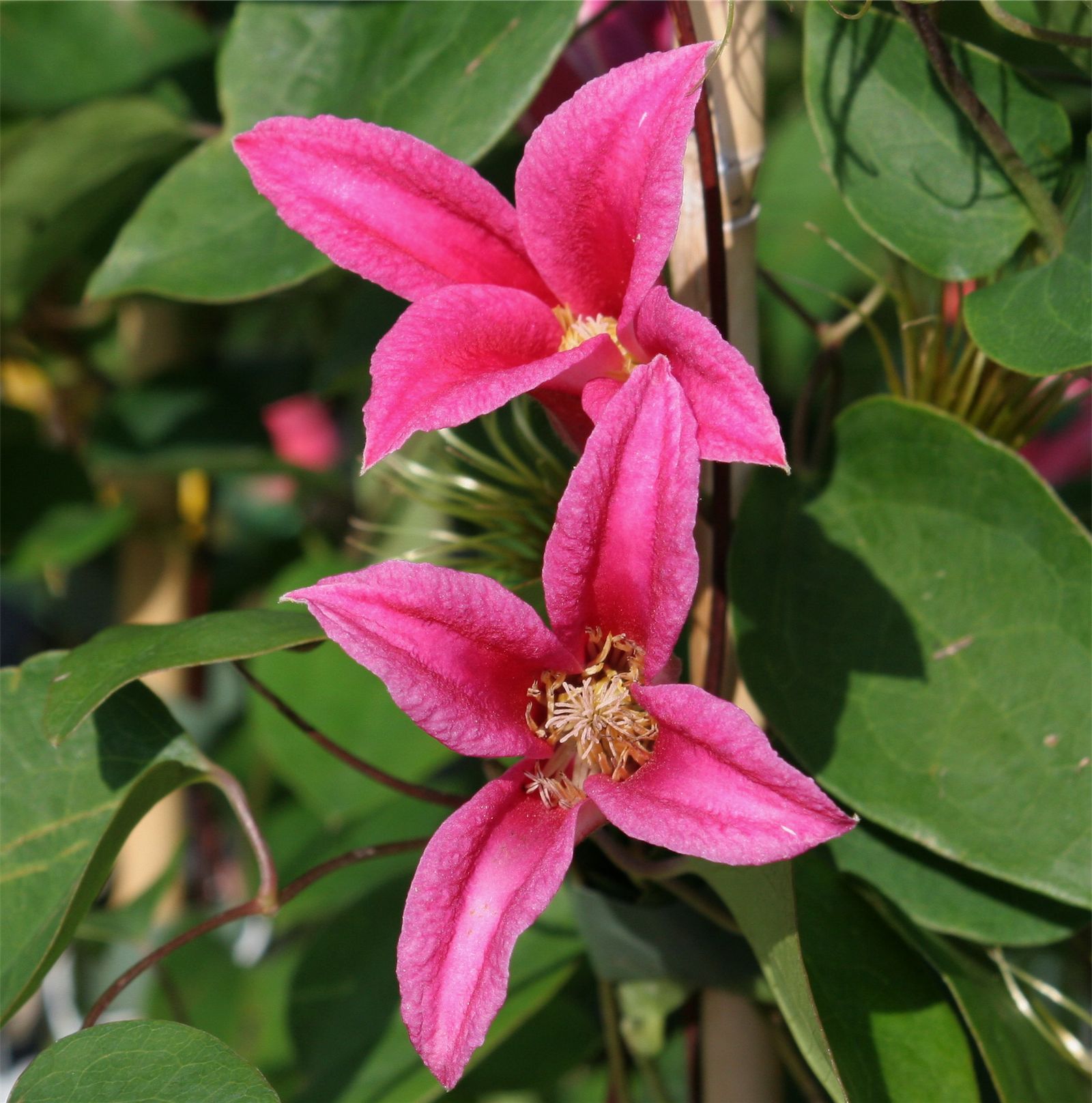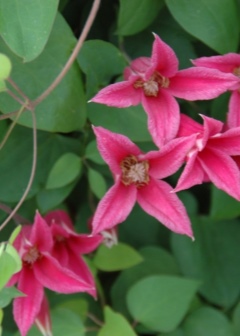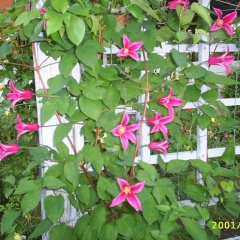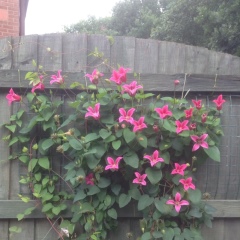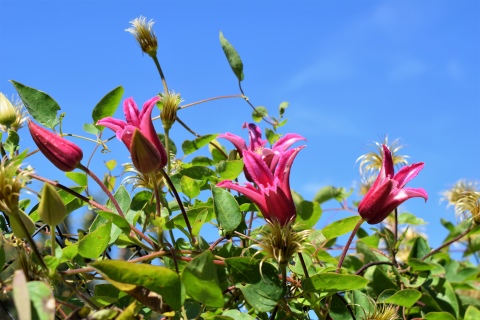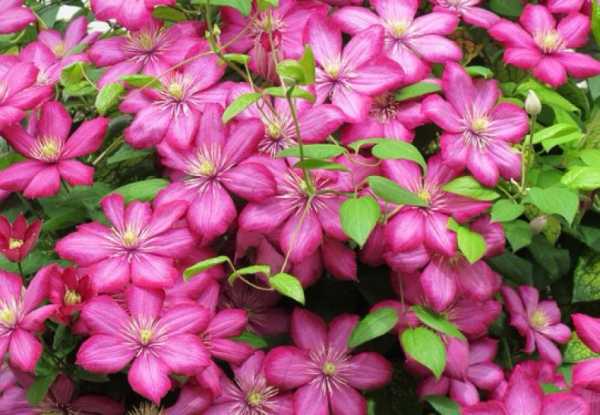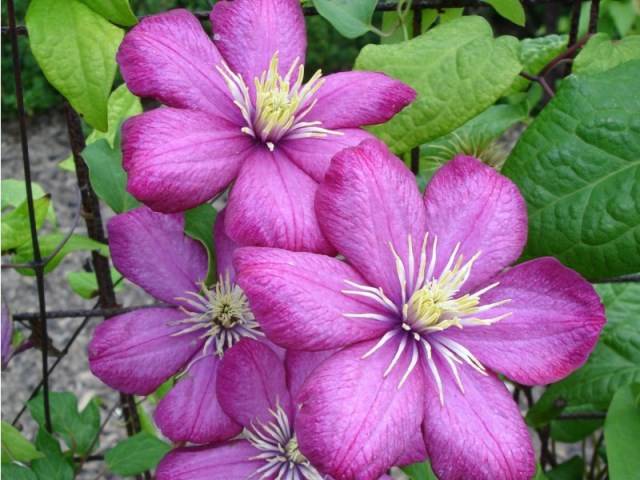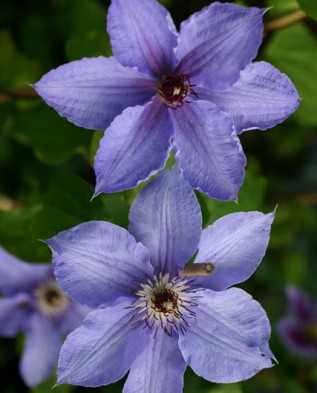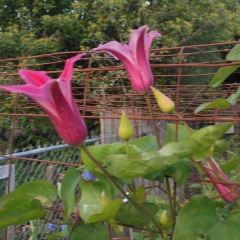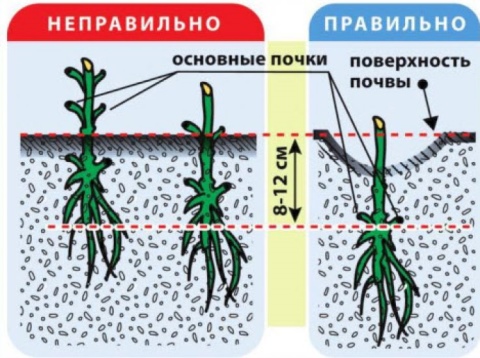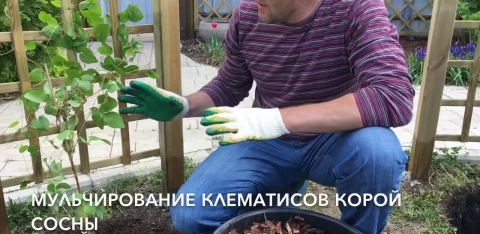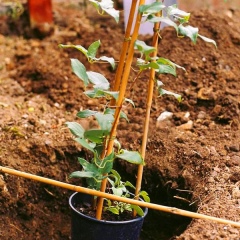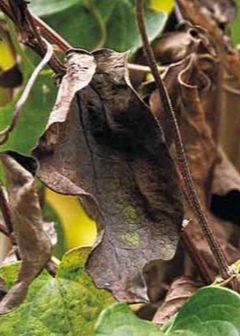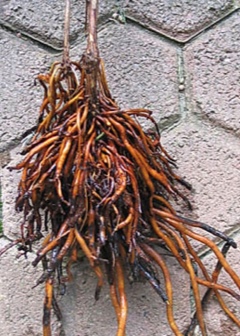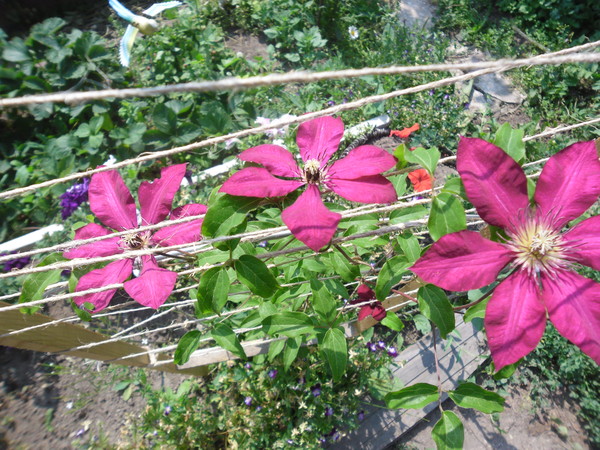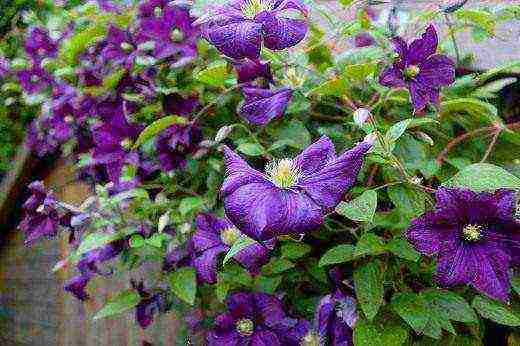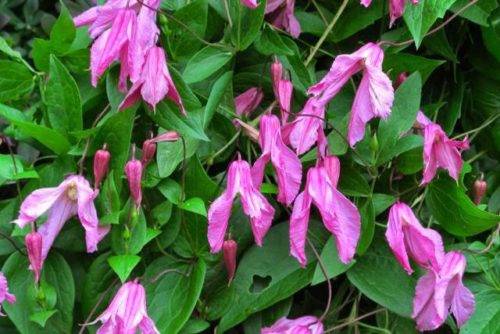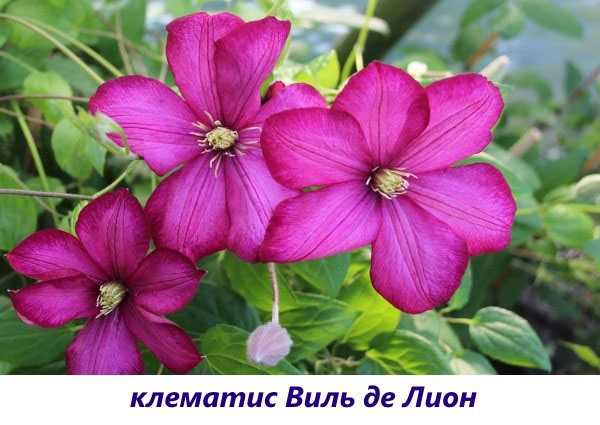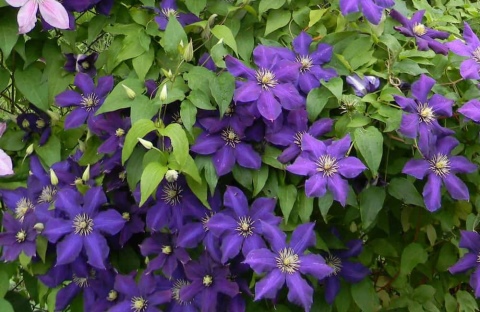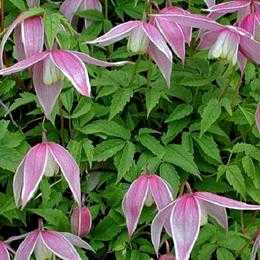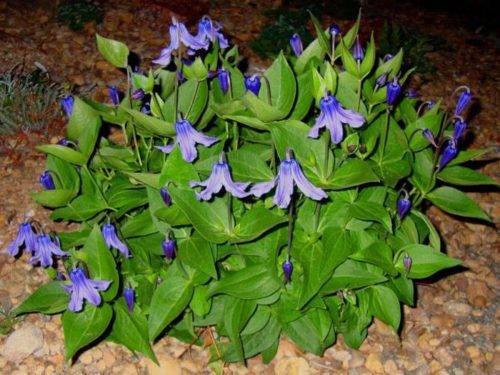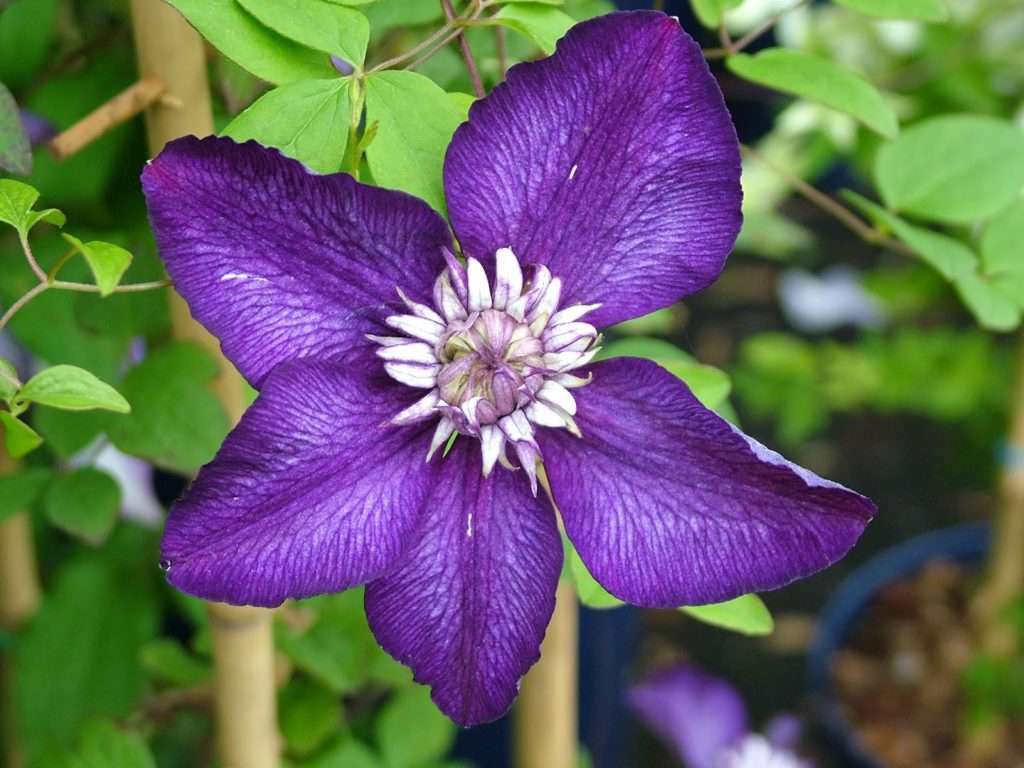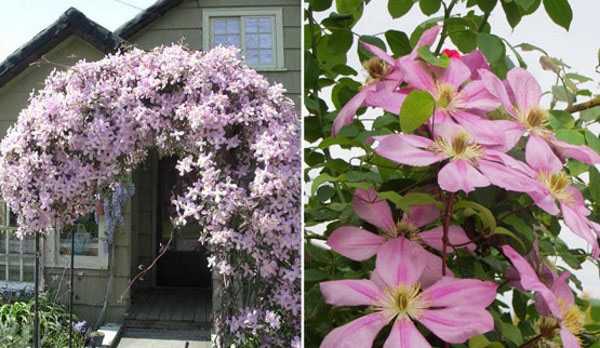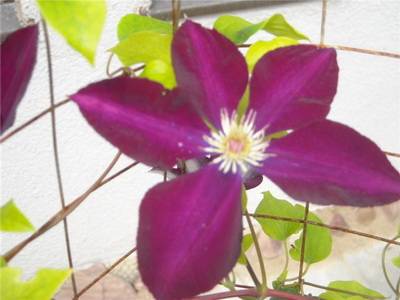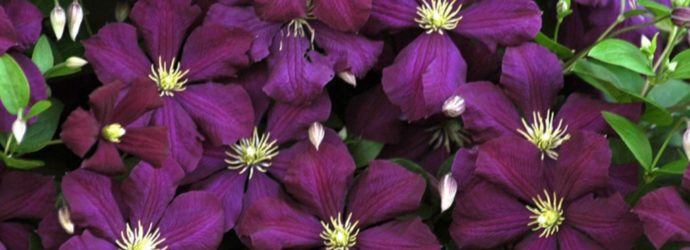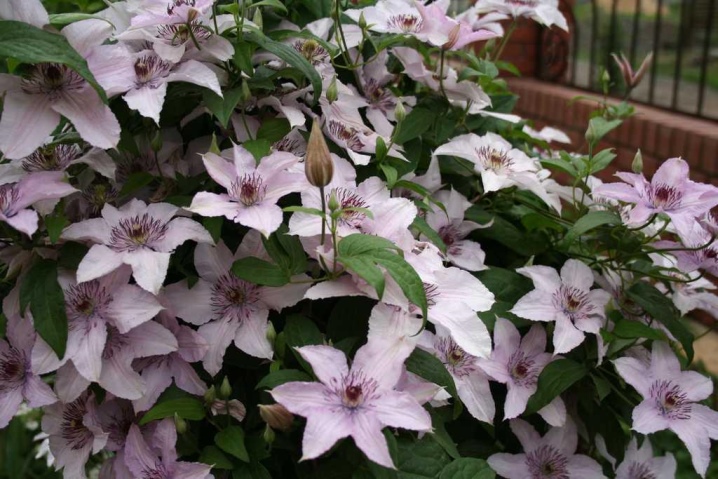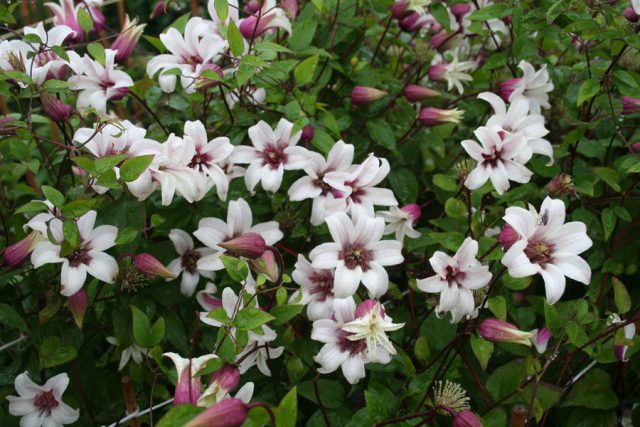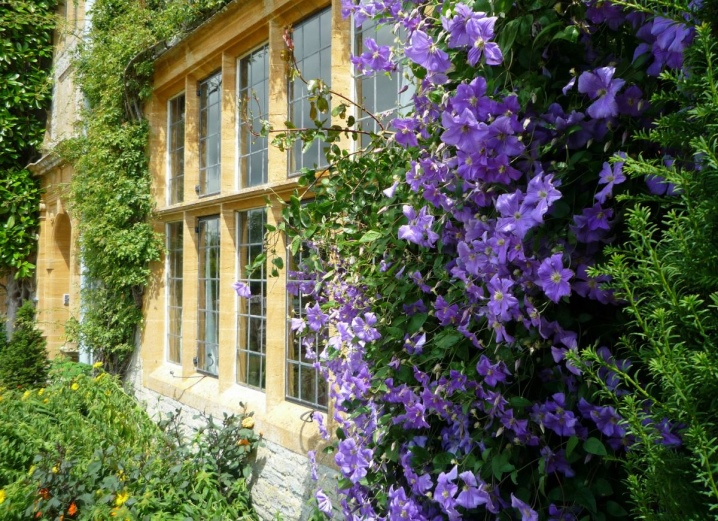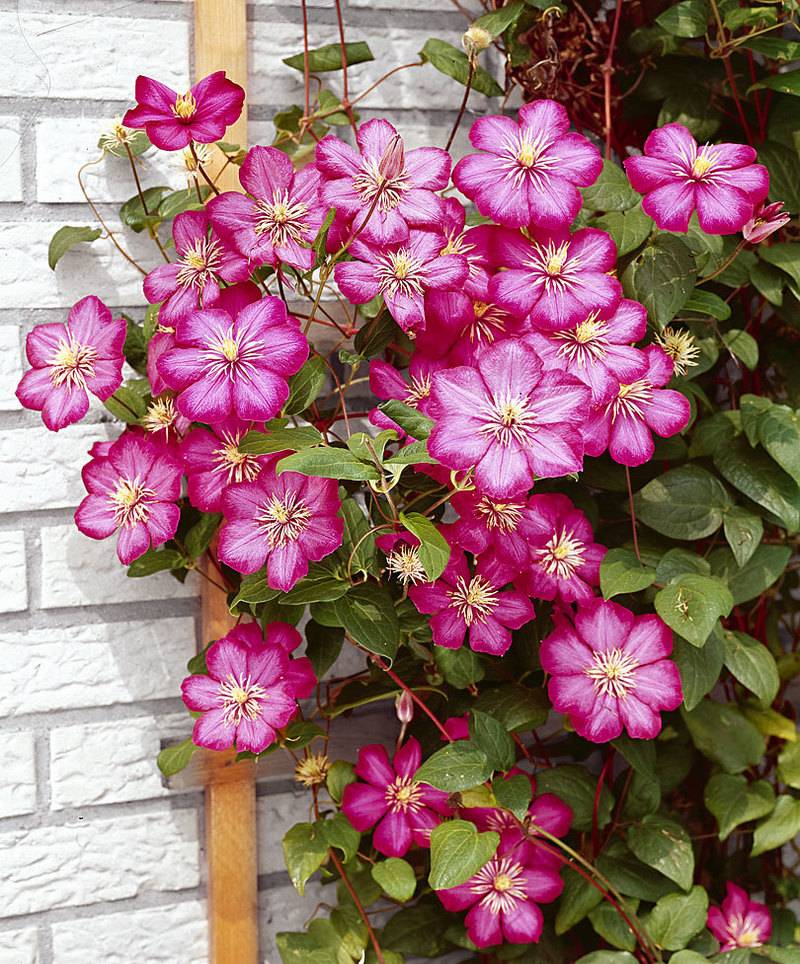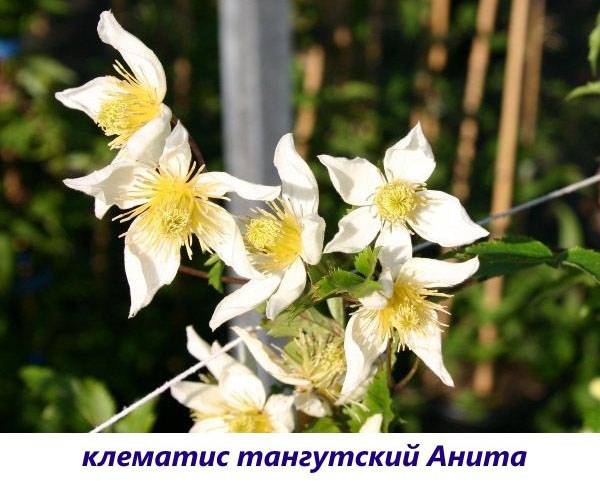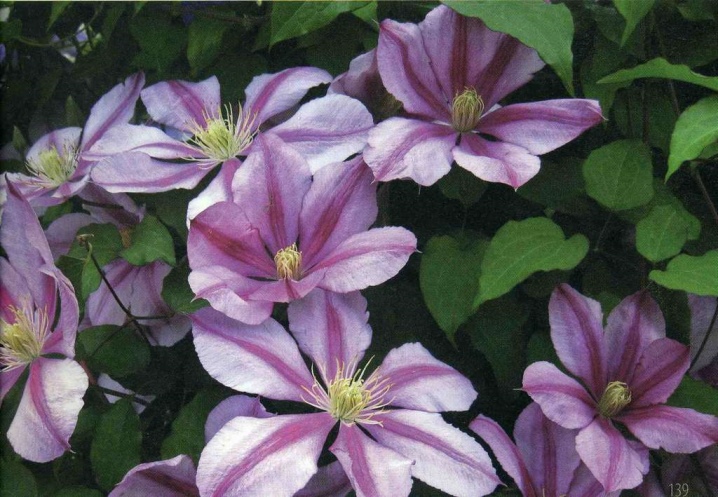Clematis Princess Kate: planting and care
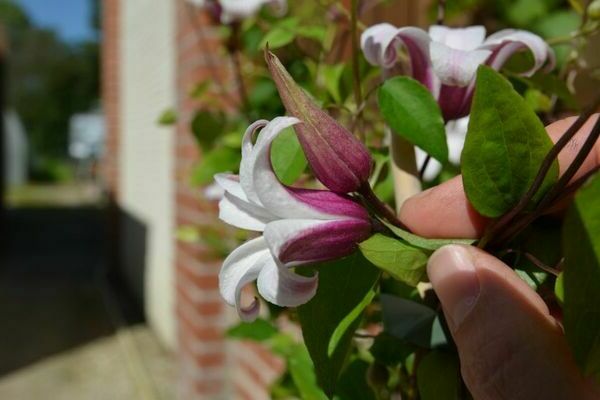
Clematis Princess Kate: photo of the variety
Clematis Princess Kate belongs to this type of plant that loves the sun's rays. Therefore, it is necessary to choose a well-lit place for growing. a slightly shaded area is fine, but the sun should be on the plant for less than 6 hours a day. Clematis do not like the wind, so choose an area that is protected from drafts. The best option for planting a plant is the south, southwest or southeast of your summer cottage. The soil should be fertile and loose; the use of loam is well suited. Sour, salty and heavy soil is categorically not suitable.
It is necessary to plant clematis of the Princess Kate variety in spring or autumn. Before landing, you need to think about the support. As we said a little earlier, the length of a plant can reach 4 m, so the length of the support should be 2-2.5 m. Also, the support cannot be installed near structures. The thing is that water, rains will drip from the roof of the building directly onto the plant, and in the same way moisture will stagnate, which will negatively affect the root system of the plant. before planting a plant, it is necessary to soak its roots in water for a couple of hours, possibly adding a root growth accelerator. it is necessary to prepare the landing pit in advance.
To do this, you need to prepare a mixture, which will consist of:
- 1 part humus.
- 1 part sand.
- 1 part garden soil.
- 0.5 l of wood ash.
- 100 g complex fertilizer.
Such a nutrient mixture must be poured into a pit in the form of a slide, a seedling must be placed on top, in which the roots need to be straightened. Sprinkle the soil, pressing firmly with your hands, so that when you water the plant, it does not fall. At the end, water and mulch the trunk circle
It is also important to check that the root collar is buried in the soil. Thus, you can protect the plant from winter frosts.
Before the seedling takes root, it must be shaded. It would be nice if you plant annuals and perennials with a shallow root system in the near-stem circle of the plant. Marigolds, phloxes, chamomiles are good for such a goal - all these plants will help protect the plant from significant overheating.
What includes a set of measures for plant care:
- Water the plant abundantly, but avoid stagnant water.
- After you plant the plant, there is no need to fertilize. The top dressing that you make when planting will be enough throughout the year. From 2 years after the planting and further in the spring, it is necessary to apply fertilizers that contain nitrogen, when the buds begin to appear - apply mineral fertilizing, after the end of flowering (end of August) - it is necessary to introduce phosphorus and potassium.
- Prune the plant every year.
- In order for the shoots to grow better, it is necessary to pinch the top of the plant.
- The liana must be tied to a support so that the plant develops and blooms correctly and beautifully.
- Take preventive measures. To do this, before planting, it is necessary to carry out processing with a 0.1% Fundazole solution. Re-processing is necessary after 15 days.
Agrotechnics
Caring for Clematis "Princess Diana" is not very difficult and comes down to the usual set of activities.
Top dressing
In the first year after planting, do not overuse fertilizers. Otherwise, the roots of the plant will begin to rot and the effect will be the opposite.Starting from the second year, fertilizers are applied according to the following scheme:
- After emergence - nitrogenous fertilizers and milk of lime.
- After the buds appear - potash fertilizers.
- After the end of flowering, phosphorus is added.
- After pruning - complex mineral fertilizer.
In rainy weather, the base of the trunk must be sprinkled with wood ash so that the vine does not start to rot. Another important nuance - during the flowering period, this decorative liana cannot be fed. If you make all the dressing correctly and according to the above scheme, then your clematis "Princess Diana" will delight you with its abundant flowering for many years.

Mulching and watering
Mulching prevents weeds from germinating, and there is no need to loosen the soil. and the plants themselves receive additional nutrients. It is best to lay out rotten manure mixed with hay and sprinkle with peat or earth on top.
Watering a young plant should be done at least once a week, and in dry weather - once every five days. The main indicator of the need for watering is the drying out of the soil.
Pruning
Throughout the growing season, dried shoots can be cut to form a beautiful lush bush. The main pruning occurs in autumn, when all shoots are pruned to 10-15 cm above ground level. If large shoots are left uncut, they will become stiff and bloom 3 weeks earlier. But at the same time, in severe winters, the danger of freezing and death of the plant remains.
Shelter for the winter
When the first autumn frosts appear, the plant is cut off. Then the base of the creeper is piled up with compost or rotten hay 12-15 cm above ground level. Mandatory treatment with a fungicide to prevent fungal diseases.
After that, cover the plant on top with a bucket or box. It is better that they are made of wood. Never cover with metal containers. Straw is poured on top or spruce branches are laid. The shelter is schematically shown in the figure:

How to plant and care?
It is recommended to plant this liana in the spring or autumn.
If the procedure is planned at the turn of March and April, it must be borne in mind that the buds should not have time to bloom. And also this year the plant will be damaged by flowering. To prevent it from happening, the buds that are forming should simply be cut off.
Autumn planting involves the procedure in late August or early September. You need to plant it before it gets cold outside, so that the plant has time to adapt, and the roots will begin to develop in the spring. Rooting becomes a guarantee that the vine will bloom next year, so planting should not be postponed.
Preparatory work
It is necessary to fertilize the soil in advance in order to fill it with nutrients. This is done 2-3 months before planting. If we are talking about spring planting of flowers, feeding is carried out before the onset of frost. It is best to use humus.
There should be more than three roots, and the minimum indicator of their length is 10 centimeters. There should be two or more strong stems, and buds should be located on each of them. If planting occurs in the spring, there should be at least two buds that have not yet blossomed, and at least three developed in the fall.
Before planting, the root system must be dried. After that, the seedling is immersed in warm water for 6-7 hours with the addition of rooting agents, among which you can use, for example, "Epin" or "Kornevin". Growth stimulants will also benefit. For prevention, treatment of the roots with a weak solution of potassium permanganate right before planting is suitable.
Landing
The planting hole should be square with a length of 60 centimeters on each side. At the bottom there is a drainage system up to 15 centimeters high. For it, you can use gravel, pebbles, broken brick. After that, the soil is filled up to the middle.
For loamy soil, the addition of sand and humus will be required. If the soil is sandy loam, you will need to fill up, in addition to humus, also peat and sand. All components must be taken in equal amounts.
The seedling is placed on a mound of soil, then its roots are gently straightened. Height to ground level should be between 5 and 15 centimeters. The hole is covered with soil and compacted a little, and a support is placed in the immediate vicinity.
Immediately after planting, it is required to mulch the soil. You can use straw, sawdust or grass for the procedure. In the case when the soil has a deficiency of nutrients, you can add peat.
Watering and feeding
Water the plant immediately after planting. After that, the procedure is repeated in the evening, approximately once every 3-5 days, on hot days a little more often. Water must flow directly to the root
It is very important not to flood the clematis, the soil should just be well moistened
Top dressing is carried out 4 times a year. Both organic and mineral fertilizers are used. The first procedure is done in early spring. The second time comes when the buds begin to form, the third - when they fade. The last fertilization takes place in September. Gardeners do not recommend feeding during the flowering period, as this can significantly reduce it.
Reproduction
Clematis "Stasik" can be propagated by layering or by dividing the bush. Seed propagation is impossible.
She is sprinkled with soil. A young stalk appears in the next season, is cut off and planted in a new place.
In the second case, it is necessary to divide the bush into 2 parts with a shovel. One of them, along with the roots, is simply planted in a new place. It is not worth worrying about the adaptation period, the plant takes root perfectly.
For more information about clematis "Stasik", see below.
Caring for clematis in the garden
Watering. In the year of planting, clematis in the garden are watered less often than roses 8-10 times, not abundantly - about 12-15 liters per plant. It also depends on the weather. But the basic rule is that the soil around the bushes should always be moist and loose.
Large-flowered clematis older than 5 years are watered in large doses, water during irrigation must penetrate to a depth of 60-70 cm, otherwise there is a shortage of it in the root zone. Up to 50 - 70 liters of water are spilled around the clematis bush (large flowering liana).
If you do not water clematis for a long time, then they suffer greatly from drying out of the soil, especially in hot weather. From this, the foliage of the plant turns pale and the flowers become smaller, the flowering period is shortened and the growth of shoots stops. Plants need to be watered infrequently, but abundantly. On hot days, they provide up to 60 liters of water per large climbing flowering plant. Watering is especially monitored during the budding and flowering period. The stream of water should not be directed into the plant to the root system in order to avoid root rot, so make a shallow groove around the plant and water into it until the bottom layer with the root system is completely shed.
Support. Clematis grows rapidly. In May, plants lengthen by 10-15 cm per day, so they need support from the very beginning of growth. The development of vines must be monitored, not allowing their interlacing, otherwise the plants bloom worse. Thin and weak shoots are removed from the very base.
Mulching. The root system often suffers not only from excessive overflow of water, but also from overheating of the soil. Therefore, several times during the summer period they add a layer of 5-6 cm to the bushes. Old sawdust, humus, mowed chopped grass from the lawn are suitable for this, or low flowering plants should be planted around the clematis bush.
Top dressing. During the growing season, clematis in the garden are fed 3-4 times.
The first feeding is done in the spring (May) after the growth of shoots: 1 tablespoon of urea, 1 liter of liquid mullein are diluted in 10 liters of water.
The second feeding is done before flowering: 1 tablespoon of potassium sulfate, "Agricola-7" is diluted in 10 liters of water.
The third feeding is carried out after mass flowering: 2 tablespoons of organic fertilizer "Flower" and "Agricola - Rose" are diluted in 10 liters of water.
The fourth top dressing is carried out at the end of growth: 2 tablespoons of Agricola for flowering plants and 1 tablespoon of potassium sulfate and superphosphate are diluted into 10 liters of water.
Consumption of working solution per bush - from 3 to 10 liters. It depends on the size of the bush.
Foliar dressing is done by spraying 10 g of "Bud" on 10 liters of water, consumption of 1 liter per 10 square meters. m. Spraying is carried out before the formation of flower buds. The processing is repeated 2-3 times over the summer.
Preparing and sheltering for winter. Clematis blooming on the shoots of the current year is prepared for winter as follows. In October, the entire vine is cut off, leaving only 2-3 knots (20 cm) from ground level. Then sprinkle with dry peat or humus. Cover with a box upside down, and cover with dry sawdust, peat or dry leaves on top with a layer of up to 30-40 cm, cover with plastic wrap on top (covering in the form of a roof), do not cover the sides with a film for ventilation.
Clematis blooming on last year's shoots also harbor. Strong developed shoots are cut at a height of 1-1.5 m from the ground, leaving 10-15 nodes, carefully removed from the supports and, having rolled up in a ring, are laid on the ground on a layer of spruce branches. Spruce branches are laid on top, the leaves are covered with a layer of 20 cm and all this is again covered with spruce branches. A film should be pulled over all shelters - it will protect plants from dampness, and spruce branches - from mice. In the spring, with the onset of warm weather, the shelter is removed. And the huddled plants gradually get rid of them.
Basic principles of agricultural technology
Like other clematis, "Princess Diana" prefers well-lit places that are protected from strong winds, but does not always like being in direct sunlight. It is best to plant a young bush so that tall fruit trees shade it for part of the day.
 For planting, it is better to choose well-lit places, partially shaded by trees or buildings.
For planting, it is better to choose well-lit places, partially shaded by trees or buildings.
In the southern regions, this variety is best planted in the fall, at the beginning of October, and in areas with colder climates, in the spring.
The planting technology is the same everywhere, but the site owner must take into account such a factor as the depth of the groundwater. If the place is "damp" - it is necessary to protect the roots of clematis from possible soaking, having previously filled in a small artificial mound at the site of the future pit
In addition, in any case, its bottom should be covered with a layer of drainage materials (stones, gravel or broken brick).
Clematis grows poorly in acidic soils. If there is a serious problem of this kind on the site, it is not recommended to take land to fill the planting hole right next to it. It is better to use commercially available soil or good humus with the addition of wood ash. When arranging a seedling in a permanent place, it is necessary to carefully spread its roots and make sure that the root collar is at least 10-15 cm below ground level. This will protect the "tillering center" from the adverse effects of very low or too high temperatures.
It is important to immediately dig in supports next to the seedling for the construction of the trellis. In the first year of a plant's life, it may not be needed, but such foresight will still not be superfluous.
If a young plant has been planted correctly, it will need the first feeding only after a year. At the beginning of the growing season (in spring), nitrogen-containing fertilizers are applied under the bush, during the flowering period - a complex phosphorus-potassium supplement. Closer to autumn, all feeding is stopped, but only in the middle - end of September, in the middle lane, it is recommended to scatter wood ash under each plant.The additive contains a lot of potassium, and its increased content in the soil contributes to the increase in winter hardiness of plants.
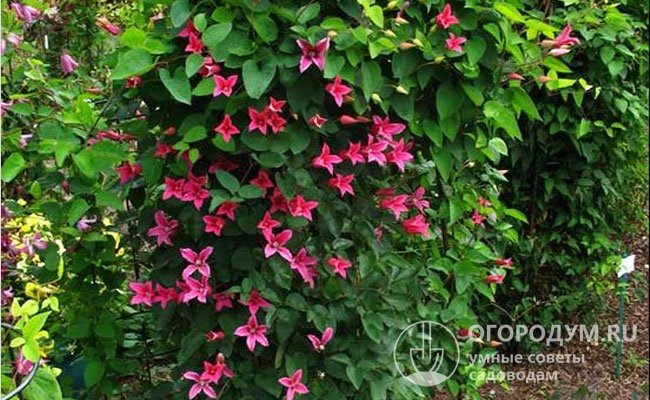 Starting from the second year of the growing season, during the period of active flowering, it is recommended to feed the bushes with phosphorus-potassium fertilizers
Starting from the second year of the growing season, during the period of active flowering, it is recommended to feed the bushes with phosphorus-potassium fertilizers
In summer, the vine is watered once a week (in severe drought, the amount of watering has to be doubled). It is useful to mulch the ground under the bush with compost, humus or peat on top, stepping back 8-10 cm from the stems. A good technique that ensures the optimal temperature in the root zone is to shade the lower part of the vine with annuals or short bushes planted nearby, but the water consumption during watering in this case needs to be increased.
Clematis "Princess Diana", according to gardeners, is quite resistant to most diseases, but can suffer from verticillary wilting (wilt). Therefore, when caring for a plant, one should not neglect annual preventive measures (for example, treating the bush and soil over its roots with "Fundazol")
In addition, it is important to observe the irrigation regime and monitor the level of soil acidity. If necessary, alkalizing additives should be regularly added under the plant, which make the soil conditions less comfortable for the causative agent of the disease.
Trimming group
"Princess Diana" belongs to the third pruning group. Before the first autumn frosts, the entire aerial part of the plant is cut off, leaving no more than 15-20 cm in length for each shoot. In warm regions, there are no problems with wintering at all. Summer residents living in the middle lane usually mulch the remaining parts of the creeper stalks to their full height with a mixture of clean sand with wood ash to protect the center of tillering in the event of prolonged snowless frosts. In those regions, which are characterized by an alternation of low temperatures with thaws in winter, air-dry shelters are built over the bushes.
Natural habitats and basic characteristics
In common parlance, the species is sometimes called "Clematis Tangut yellow". Mongolia, the western regions of China and the southeast of Central Asia are considered its homeland. In the wild, it usually exists in the form of a low-growing (no higher than 50 cm) shrub that forms dense thickets. When cultivated in a horticultural culture, clematis grows in the form of a liana with a stem length of up to 3-4 meters. Let's consider its main characteristics in the table:
| Parameter | Characteristic |
| Genus | Clematis or Clematis |
| Growth form | Shrub vine |
| Type of | Small-flowered |
| Group | Tangutica |
| general characteristics | Climbing, small-flowered, unpretentious plant with a powerful root system and actively growing shoots |
| Appointment | Vertical and ground cover gardening in landscape design |
| Life cycle | Perennial |
| Reproduction methods | Seeds, cuttings, dividing the bush, layering |
| Shoot length | Up to 3-4 m |
| Flowering type | On the shoots of the current year |
| Flowering period | In the middle lane: from early June to mid-autumn |
| Flower sizes | Up to 4 cm in diameter |
| Coloring flowers | Petals are yellow, anthers are light (usually cream-colored) |
| 3rd, but radical pruning for the winter is not necessary | |
| Sustainability | Frost resistance and drought resistance are high; is poorly affected by common diseases and pests |
| Registration in the State Register of the Russian Federation | Turned off |
Biological features of the plant
The bushes have a powerful root system and actively growing shoots. The leaves are feathery, on flexible petioles, with which the plants "cling" to the support, quickly creating openwork "green walls". An adult liana for a season can completely cover a section of a wall with an area of up to 5 square meters.
Actively growing shoots, clinging to the supports with flexible leaf stalks, quickly braid vertical as well as horizontal structures
The flowers are drooping, cruciform, up to 4 cm in diameter. Each one consists of 4 elongated, pointed yellow petals. Anthers are light, more often creamy. During blooming, the buds look like small lanterns, and when opened, they look like bells. Unlike the large-flowered species, this plant perfectly sets seeds, which give it an extra charm. Each seed has a long, flexible, fluffy "tail" of silvery-white color. A photo of Tangut clematis, taken in the middle or at the end of the summer season, looks very peculiar: unblown buds, open flowers and lush "bunches" consisting of ripe or ripening seeds are simultaneously present on the bush.
Plants have buds, open flowers and fluffy seed clusters at the same time
The flowering period in the middle lane begins in June and lasts almost until the cold weather (sometimes with short interruptions). The seeds ripen by the end of September, but do not fall off themselves; their fluffy growths can persist on the branches until spring. The plasticity and exotic appearance of the bushes make it possible to use the plant both for braiding vertical supports (pillars of gazebos and verandas, walls of buildings) and for creating garden compositions requiring horizontal placement of shoots (alpine hills, low stone walls intended for zoning a site, etc. .).
Clumps of ripe seeds do not fall off and can remain on the branches until spring
The love of gardeners is enjoyed not only by the original botanical species of Tangut clematis, but also by hybrid varieties derived from it. The following varieties are most popular:
- Golden tiara. Tall liana. Flowers up to 6 cm in diameter, at the beginning of blooming have the shape of a bell, but by the end they open completely. The color of the petals is bright, dark yellow, the stamens and anthers are dark brown;
- "Love Radar" (for some sellers it appears under the name "Love Locator"). Shoot length up to 3 meters. Flowers are light yellow, drooping, 4-5 cm in diameter, dark anthers;
- Bill Mackenzie. Liana with stems up to 7 meters long. The flowers have the shape of drooping "lanterns", they do not fully open. The color of the petals is light yellow, the anthers are light brown;
- Anita. Shoot length up to 4-5 meters. The flowers are small (3-4 cm in diameter) and consist of 4-5 petals. Fully disclosed. The color of the petals is white or pale cream, the anthers and stamens are golden yellow;
- "Grace". The bush is moderately vigorous (about 3 meters). The color of the petals is beige, the stamens are greenish-yellow, the anthers are brownish.
In the photo - flowers of clematis of popular varieties: "Bill Mackenzie", "Anita" and "Grace"
All clematis belonging to the tangutica group are excellent ornamental plants that are unpretentious and easy to care for, quite suitable for decorating garden plots.
Clematis Stasik: description and characteristics
Clematis Stasik: photo
Such a plant looks like an ordinary shrub vine, the plant reaches a length of four meters, twists. To grow upward without falling to the ground, clematis is helped by its clinging petals that curl along the surfaces.
Clematis Stasik grows upward, and entwines structures, can reach an interweaving of stems of about two meters. The structure of such a plant is thin, but at the same time very strong. The stem color is brownish. The petals are ordinary, classic, this is acceptable for the genus Lyutiklov. There are also cases when the petals cross and grow in the form of triple ones, it all depends on the region of their cultivation, on the climatic conditions.
The inflorescences of clematis Stasik are large in size, the parameters are from ten to twelve centimeters, this can be instantly noticed, despite the fact that clematis has thin stems.The inflorescences bloom quite dimensionally, along with this, the flowers overlap each other, but this way this plant looks even more beautiful and aesthetically pleasing, as if the veil of flowers, stems and petals is practically invisible because of the buds.
Clematis of the Stasik variety looks like a star, it has six petals in the bowl of the bud, the shape is an elongated circle, a little angular at the tips. The petals on the surface are as rough as velvet.
The color of the buds is initially wine-colored, lightens over time, turns into plum color. White specks in the middle of the bud. The anthers of the inflorescences are darkish, give off a plum color
Blossoms in the middle of summer. Attention! The flower ripens for the running years
A large number of types of such a plant are formed. Clematis is part of the Buttercup family. There are other options for recognizing clematis, or rather its creation. His families. This type of clematis ripens late in comparison with the main ones.
This species was developed by a popular agronomist, gardener, Masha Sharanova, in the seventies, or rather in one thousand nine hundred and seventy-two, by crossing cultures. Clematis was named Stasik in honor of Maria's grandson.
Clematis Stasik: trimming group
The types of such a plant are formed into certain compositions along the cut. Clematis Stasik belongs to the third group of pruning, that is, to the "strong" composition. It includes a large cluster of branchy and climbing plants, as well as those that bloom in the middle of summer. Clematis Stasik is cut over 2 or 3 inflorescences, length in height is from twenty to fifty centimeters above the ground.
This method of cutting clematis, which ripen in the late period, is used in most cases, so that the plant does not thicken and looks neat and attractive. All dry petals and stems are also cut off, at the level of the soil under the root, and at the distance of the stem from the ground by five or ten centimeters.
Features of clematis Stasik
The light for such an inflorescence is something special. Clematis is very fond of light, but you need to keep the edge in lighting so as not to dry out, this applies more to the south of the continent, and in the northern part, on the contrary, you need to plant so that the light is constant.
Clematis Stasik does not perceive the wind and an empty area not fenced off by anything
In winter, it is especially important that the clematis is fenced and draft-free. In winter, snow flies off clematis, so it kills plant embryos with the help of frost, and growing a plant in the next season is impossible.
For good growth of clematis Stasik, the soil must be nourished with useful minerals, it is also necessary that the earth be loose, oxidized and not compacted.
Clematis Static does not tolerate a large amount of moisture, so it cannot be grown in depths or ditches, it simply will not survive in such conditions. If conditions do not allow, then drainage can be built.
In most cases, clematis is grown in the form of a woven wall, but between the stems there should be an intermediate up to seventy centimeters in size. The location of clematis should be such that the entire plant is covered with light.
Clematis Stasik endures the winter season, he is not afraid of frosts from minus seven degrees to minus thirty-five degrees. Agronomists are preparing for the winter, so that the clematis of the Stasik variety can withstand any weather. Clematis is planted even in the north.

